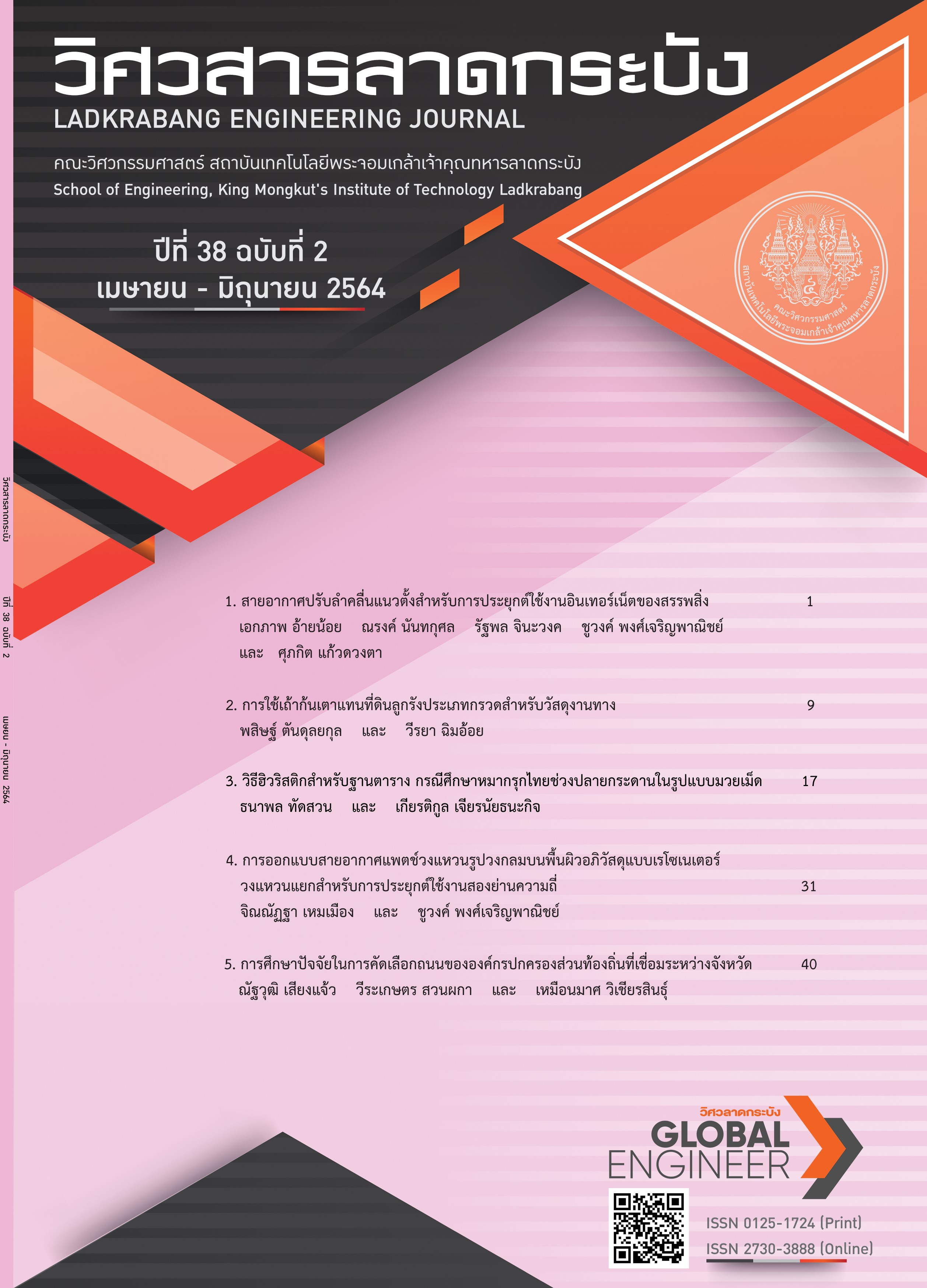Vertical Beam Adjustable Antenna for Internet of Things Applications
Keywords:
Adjustable Beam Antenna, Long Range Wide Area Network (LoRaWAN), PIN diode and Parasitic PatchAbstract
This article presents switched beam antenna for Long Range Wide Area Network (LoRaWAN) in the frequency of 920-925 MHz. The proposed antenna can be switched in four direction of the elevation plane. The antenna structure consists of a wire monopole antenna placed on the ground plane with surrounding four parasitic patches and four PIN diodes are used to switched beam of the antenna. From simulated and measured results, it is found that the proposed antenna has an input impedance of 50 W, |S11| less than -10 dB in the frequency of 920-925 MHz and antenna gain equal to 2.48 dBi. It can be efficiently to switch main beam of the antenna in four directions on the elevation plane.
References
C. Khunboa, “IoT Architecture: Internet of Things”, Se-Ed, Bangkok, 2019.
L.H. Trinh, T. Q. K. Nguyen, D. D. Phan, V. Q. Tran, V. X Bui, N. V. Truong and F. Ferrero, “Miniature Antenna for IoT Devices Using LoRa Technology,” 2017 International Conference on Advanced Technologies for Communications (ATC), pp. 170-173, October 2017.
Q. Zhang and Y. Gao, “Embedded Antenna Design On LoRa Radio for IoT Applications,” 12th European Conference on Antennas and Propagation (EuCAP 2018), pp. 1-3, April 2018.
V. Ludwig-Barbosa, E. Schlosser, R. Machado, F. G. Ferreira, S. M. Tolfo and M. V. T. Heckler , “Linear Array Design with Switched Beams for Wireless Communications Systems,” International Journal of Antennas and Propagation, Vol. 2015, Article ID 278160, pp. 1-9, April 2015.
D. R. Jahagirdar and K. Sambasiva Rao, “Design and Development of Electronic Beam Switching Antenna for Point-to-Multipoint Long Range Data Link Applications,” 2017 IEEE International Conference on Antenna Innovations & Modern Technologies for Ground, Aircraft and Satellite Applications (iAIM), Bangalore, India, pp. 1-4, November 2017.
Y. Li and Z.-C. Hao, “A Wideband Switched Beam Antenna for Full 360° Coverage,” 2017 Sixth Asia-Pacific Conference on Antennas and Propagation (APCAP), Xi'an, China, pp. 1-3, October 2017.
C. W. Jung, M.-J. Lee, G. P. Li and F. De Flaviis, “Reconfigurable Scan-Beam Single-Arm Spiral Antenna Integrated with RF-MEMS Switches,” IEEE Transactions on Antennas and Propagation, Vol. 54, no. 2, pp. 455-463, February 2006.
S. Cheng, P. Rantakari, R. Malmqvist, C. Samuelsson, T. Vaha-Heikkila, A. Rydberg and J. Varis, “Switched Beam Antenna Based on RF MEMS SPDT Switch on Quartz Substrate,” IEEE Antennas and Wireless Propagation Letters, Vol. 8, pp. 383-386, March 2009.
Y.-Y. Lin, C.-L. Liao, T.-H. Hsieh and W.-J. Liao, “A Novel Beam-Switching Array Antenna Using Series-Fed Slots With PIN Diodes,” IEEE Antennas and Wireless Propagation Letters, Vol. 16, pp. 1393-1396, December 2016.
V. A. Nguyen and P. S. Ook, “Compact Switched and Reconfigurable 4-ports Beam Antenna Array for
MIMO Applications,” 2011 IEEE MTT-S International Microwave Workshop Series on Intelligent Radio for Future Personal Terminals, Daejeon, South Korea, pp. 1-3, August 2011.
L. H. Trinh, T. N. Le, R. Staraj, F. Ferrero and L. Lizzi, “A Pattern-Reconfigurable Slot Antenna for IoT Network Concentrators,” Electronics 2017, 6, 105, pp. 1-7, November 2017.
S. V. Shynu Nair and M. J. Ammann, “Reconfigurable Antenna With Elevation and Azimuth Beam Switching,” IEEE Antennas and Wireless Propagation Letters, vol. 9, pp. 367-370, April 2010.
Infineon Technologies, Silicon PIN Diodes, BAR63, datasheet October 1999.
C. A. Balanis, Antenna Theory: Analysis and Design, 3rd ed. Hoboken, NJ, USA: Wiley, 2005.
Downloads
Published
How to Cite
Issue
Section
License
Copyright (c) 2021 Faculty of Engineering, King Mongkut’s Institute of Technology Ladkrabang

This work is licensed under a Creative Commons Attribution-NonCommercial-NoDerivatives 4.0 International License.
The published articles are copyrighted by the School of Engineering, King Mongkut's Institute of Technology Ladkrabang.
The statements contained in each article in this academic journal are the personal opinions of each author and are not related to King Mongkut's Institute of Technology Ladkrabang and other faculty members in the institute.
Responsibility for all elements of each article belongs to each author; If there are any mistakes, each author is solely responsible for his own articles.






